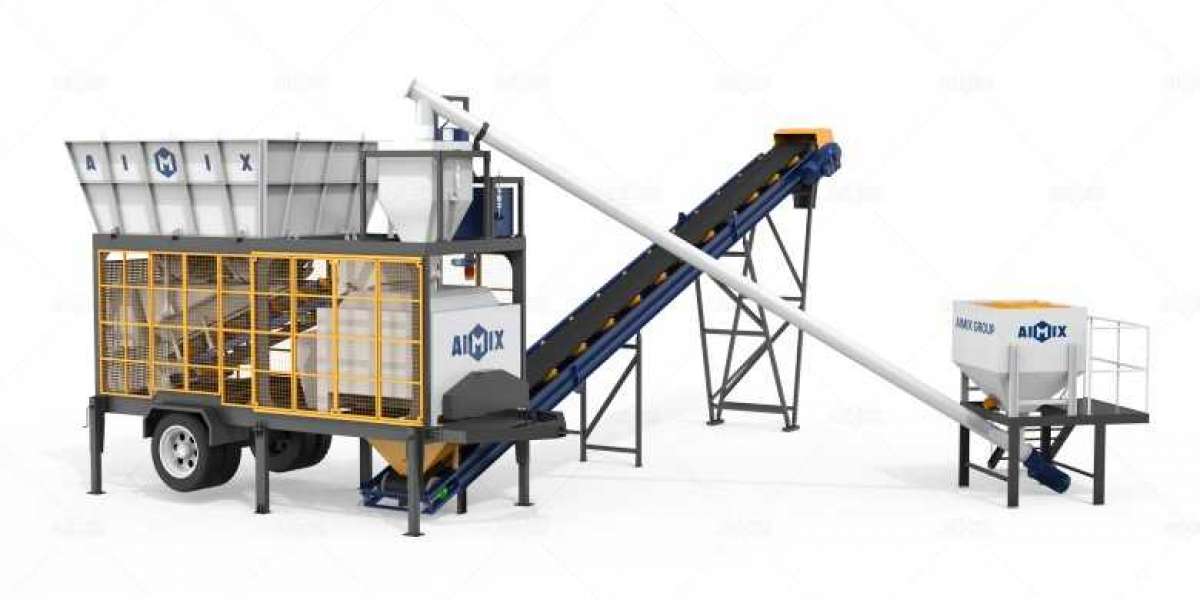In the fast-paced world of construction, speed, flexibility, and efficiency are no longer luxuries—they’re necessities. As project timelines shrink and the demand for concrete remains strong across infrastructure, commercial, and residential developments, the need for smarter, faster, and more adaptable equipment has never been greater. This is where portable concrete batching plant technology is stepping into the spotlight.
The next generation of these mobile systems is being defined by modular design and plug-and-play functionality. Together, they are revolutionizing how concrete is produced on-site, offering unmatched setup speed, scalability, and operational control. This article explores how these two innovations are shaping the future of portable concrete batching plants—and why they matter for today’s contractors and developers.

1. The Evolution of Portable Concrete Batching Plants
Traditional concrete batching plants—particularly stationary ones—have served the industry for decades. While they offer high output and precision, they often come with significant setup times, permitting requirements, and site infrastructure demands.
Portable concrete batching plants, by contrast, are designed to be transported to the job site and installed quickly. Initially, these plants still required significant manual labor and technical expertise to set up. But recent technological advancements have introduced modular, pre-engineered units and plug-and-play systems that make deployment dramatically faster and easier.
2. What Does Modular Mean in Batching Plant Design?
In the context of batching plants, modular design refers to breaking down the plant into standardized, prefabricated sections—or modules—that can be assembled and disassembled quickly. Each module represents a major component of the batching plant, such as:
Aggregate batching system
Cement silo and weighing system
Water and admixture dosing
Mixing unit
Control cabin
These modules are factory-assembled, pre-wired, and pre-tested before shipping, reducing the on-site installation time from several days (or even weeks) to just a few hours.
Key benefits of modular design:
Rapid deployment: Ideal for time-sensitive projects
Easy relocation: Perfect for contractors handling multiple job sites
Simplified logistics: Easier to transport using standard containers or trailers
Reduced labor: No need for extensive civil work or skilled setup crews
3. Plug-and-Play Functionality: What It Means and Why It Matters
Plug-and-play functionality takes modularity a step further. In these systems, once the modules are connected mechanically, operators simply need to connect power, water, and control lines—no complex programming or rewiring is required.
Think of it like assembling a high-performance machine with snap-in components and preloaded software. The control system is often pre-configured, with digital calibration and automated startup sequences built in.
Benefits of plug-and-play in portable batching plants:
Reduced setup time and commissioning
Lower risk of errors during installation
Instant startup and remote diagnostics
Minimal training required for operators
For example, a plug-and-play portable concrete batching plant can be fully operational within 6–12 hours of arrival on site, compared to the 2–5 days often needed for traditional mobile plants.

4. Why This Matters for Modern Construction Projects
Whether it's a remote road-building project, a fast-paced urban development, or disaster relief construction, time and mobility are key constraints. The ability to deploy a portable concrete batching plant in a matter of hours rather than days gives contractors a crucial advantage.
Some key applications include:
Short-term or fast-track projects where delays are costly
Projects in remote locations where fixed infrastructure is not feasible
Multi-phase developments where the plant needs to move with progress
Projects with tight environmental or zoning regulations, where compact design is critical
By reducing setup complexity and enabling batch-on-demand concrete production, modular and plug-and-play plants improve efficiency, reduce cost, and increase jobsite independence.
5. Integration with Smart Technology
The most advanced portable concrete batching plant machine also integrate digital control systems, offering:
Real-time production monitoring
Automated batching accuracy
Remote access and diagnostics via IoT
Cloud-based data logging and compliance tracking
This further enhances the plug-and-play experience, enabling operators to manage and optimize concrete production with minimal intervention and maximum consistency.
Some systems even offer integration with fleet management software and digital project planning tools, making them part of a broader digital construction ecosystem.
6. Environmental and Operational Benefits
Aside from speed and flexibility, modular and plug-and-play plants contribute to sustainability and operational efficiency:
Lower carbon footprint: Reduced logistics and shorter setup times lead to fewer emissions
Less site disruption: Minimal ground preparation and faster relocation
Water-saving features: Many come with integrated water recycling systems
Noise and dust control: Compact enclosure designs limit impact in urban settings
These features align with growing demand for ESG-compliant construction practices and make modern portable plants more attractive to environmentally conscious developers and regulators.
7. What to Look for When Choosing a Modern Portable Plant
If you’re in the market for a portable concrete batching plant with modular and plug-and-play features, consider:
Output capacity (typically 25–60 m³/h for portable models)
Level of automation and control system capabilities
Ease of transport and installation
Support and warranty from the manufacturer
Availability of optional features, such as dust filters, aggregate pre-feeders, or solar power integration
Leading manufacturers now offer comprehensive solutions tailored for different project types, climates, and mobility needs.

Conclusion
The construction industry's future is modular, mobile, and intelligent—and portable concrete batching plants are evolving to meet that vision. With modular design and plug-and-play technology, contractors can significantly reduce setup time, improve concrete quality control, and boost operational efficiency, all while staying agile across multiple project sites.
As demand grows for faster, greener, and more adaptable solutions, investing in this next generation of batching plant technology isn't just smart—it's essential for staying competitive in the modern construction era.







